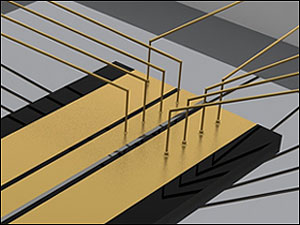World’s most powerful terahertz laser chip
February 20, 2014
University of Leeds researchers have taken the lead in the race to build the world’s most powerful terahertz laser chip.
Terahertz waves, which lie in the part of the electromagnetic spectrum between infrared and microwaves, can penetrate materials that block visible light.
They have a wide range of possible uses, including chemical analysis, security scanning, remote sensing of chemical signatures of explosives in unopened envelopes, non-invasive detection of cancers in the human body, and high-bandwidth telecommunications.
But one of the main challenges for scientists and engineers is making the lasers powerful and compact enough to be useful. A paper in the Institution of Engineering and Technology’s (IET) journal Electronics Letters reports that the Leeds team has now exceeded 1 Watt output power from a quantum cascade terahertz laser facet measuring only a few square millimeters in size, operating at 3.1 THz.
The new record more than doubles landmarks set by MIT and a team from Vienna.
“The process of making these lasers is extraordinarily delicate,” said Edmund Linfield, Professor of Terahertz Electronics in the University’s School of Electronic and Electrical Engineering. “Layers of different semiconductors such as gallium arsenide are built up one atomic monolayer at a time. We control the thickness and composition of each individual layer very accurately and build up a semiconductor material of between typically 1,000 and 2,000 layers.
This work was mainly funded by the Engineering and Physical Sciences Research Council (EPSRC).
Abstract of Electronics Letters paper
Terahertz (THz) frequency quantum cascade lasers emitting peak powers of >1 W from a single facet in the pulsed mode are demonstrated. The active region is based on a bound-to-continuum transition with a one-well injector, and is embedded into a surface-plasmon waveguide. The lasers emit at a frequency of ∼3.4 THz and have a maximum operating temperature of 123 K. The maximum measured emitted powers are ∼1.01 W at 10 K and ∼420 mW at 77 K, with no correction made to allow for the optical collection efficiency of the apparatus.
